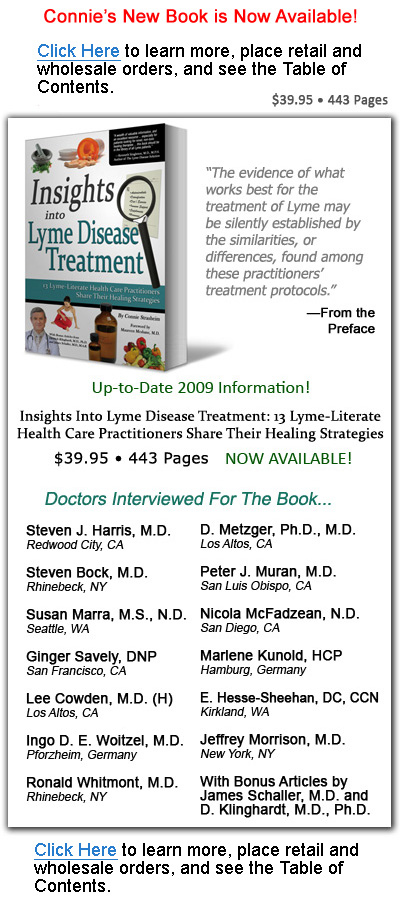Welcome To Lyme Bytes!
April, 2014- HELLO ALL! I am no longer posting to this blog. For the latest on me and my work, I invite you to subscribe to my NEW blog: www.conniestrasheim.blogspot.com where I share my latest findings on how to heal from chronic illness involving Lyme and other conditions. Thanks!
Greetings and welcome to my Lyme disease blog, a comfy cozy (and sometimes crazy!) place for cutting-edge information, encouragement and insight into the fastest-growing epidemic disease in the United States. In this blog you will find everything from bug-killing strategies to immune system and hormone help, as well as lifestyle and spiritual suggestions for healing from chronic illness involving Lyme disease. The information contained within this blog is based upon my own healing journey and what I have learned over the past eight years as I have been diligently digging and researching my way back to a better state of health. May you find it to be a source of hope, inspiration and wisdom in your own journey towards wellness.
About "Insights Into Lyme Disease Treatment"
About the book:
Published August, 2009
Written by Connie Strasheim
Learn More - Bulk Orders - Table of Contents
Monday, April 30, 2007
Insights Into Detoxification Ability
First, men are less prone to the effects of toxins, because they tend to be heavier and with a lower percentage of body fat than women. Since toxins are stored in fat, women get shortchanged (as in nearly all aspects of chronic illness). Lifestyle, age, exposure to toxic sources, not exercising, and having compromised immune function are other factors which determine how a person will respond to toxins. Often underestimated is the role of emotional toxins, and how unprocessed trauma impacts the body's overall functioning.
In the process of detoxification itself, enzymes must be present, and some folks are born with a genetic defect that causes them to produce fewer enzymes than others. Further, sufficient levels of vitamins and minerals must be present in order for the body to utilize these enzymes. Insufficient dietary intake of nutrients or metabolic inefficiencies will leave the enzymes paralyzed or inactive, which means that the toxic garbage doesn't get broken down and shuttled out of the body.
The job of detoxification is assigned first and foremost to the liver, and secondly, to the skin, kidneys and lungs. In fact, the liver is thought to have three times the detox capacity as the kidneys and other organs, and will break down and remove substances that the others cannot.
Liver detox takes place in two phases. In the first, the toxic chemical gets "prepped", so that in phase two, a molecule may be added or removed which will enable it to become water soluble and hence more easily excreted by the body. More than fifty enzymes under the direction of thirty-five genes are required for phase one to be carried out. Hmmm....kind of makes me wonder what would happen if a person was missing just one of these?
It also underscores the importance of taking enough minerals so that the myriad of enzymes are fed and fueled up for the task at hand.
Ordinarily, the toxin make-over that a chemical gets in phase one renders it more harmless to the body in phase two, but this isn't always the case. Sometimes, reactive chemicals are formed which end up making the toxin scarier and more harmful to the body than it was before it went through phase one. Now, this is no problem if phases one and two are balanced in their activities, and that scary chemical ends up being broken down in phase two. But if they are not, the toxin may remain in the body, even uglier now than before the liver got ahold of it!
Both phases require an abundance of nutrients, including fatty acids, aminos, vitamins and minerals. While this may be common sense, what is probably less obvious is that heavily toxic folks require more of the above than someone with a lower overall toxic burden. Also, protein deficiency is associated with reduced phase one action, and a low-calorie diet impacts detox functions overall. One of the processes of phase two, which involves detoxing of drugs, hormones, food additives, heavy metals and neurotransmitters requires more energy than other reactions and will not take place when energy is low.
With the unique metabolic and detoxification problems that most Lyme sufferers have, it would be wrong to assume that tweaking the diet alone can fix any detox issues. Yet, in the quest towards health, it may help to understand the complexities of the body's eliminatory capabilities, so that new strategies for aiding the body can be devised.



No comments:
Post a Comment